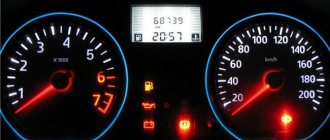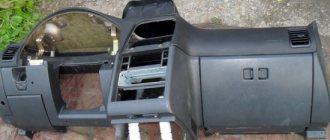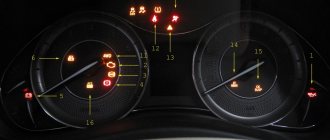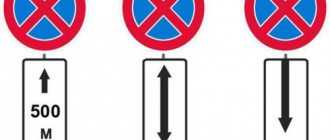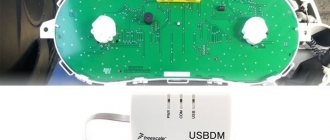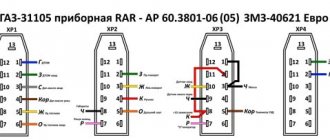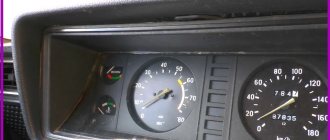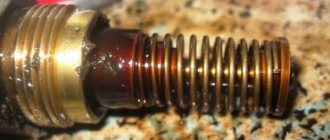Designation of light bulbs and sensors on the tidy
First, let's take a look at the location and description of the components of the dashboard in the Lada Vesta:
- Tachometer. Thanks to this device, the driver knows what the crankshaft operating frequency is, that is, at what speed the engine operates. Do not allow the instrument needle to move into the red zone, as this may lead to damage to the power unit. If you press the gas pedal to the floor, while the speed exceeds 6200 rpm, the fuel supply will be limited. Experts also recommend not allowing the engine to operate in a dangerous mode, when the speed is less than 800 per minute.
- "Pedal adjustment" indicator.
- The seat belt icon is always on if the driver or passenger is not fastened.
- Airbag indicator. If it appears for no reason, the problem may be a failure of the airbag sensor or its poor contact with the electrical network.
- A backup light bulb can be connected when installing additional devices or systems.
- Brake failure indicator; when it appears, you should stop the car and check that the brakes are working properly.
- The trunk door is unlocked icon; when it appears, you should check the trunk.
- Unlocked hood symbol. If it starts to light up on the dashboard, while the hood is normally closed, you need to check the functionality of the sensor.
- Speedometer. This device is considered one of the main ones, since the driver pays attention to it more often than others. The device is used to demonstrate the speed of movement.
- The hazard warning light icon always flashes when the hazard lights are activated.
- Symbol of unlocked doors. If the car starts moving with one or more doors open, a corresponding light will appear on the dashboard.
- Cruise control system indicator.
- The speed limiter indicator appears if the driver exceeds the permissible speed.
- This device indicates the temperature of the antifreeze in the cooling system. If the indicator fails, the vehicle cannot be operated as it reports the engine temperature. If this value exceeds the permissible value of 115 degrees, the light will light red without interruption, and the buzzer should also sound briefly. At high temperatures, the engine may simply fail.
- Icon of the standard anti-theft system - immobilizer.
- Icon for turning on side lighting.
- Symbol for switching on low beam.
- LED high beam activation icon.
- The indicator for turning on the front PTFs always appears when they are activated.
- The icon for turning on rear-mounted foglights is similar.
- ESC light - electronic stability control system.
- The ESC OFF symbol indicates that the system is turned off.
- The fuel level sensor in the tank is used by the driver to guide him when he needs to refuel the car.
- The reserve fuel volume activation icon appears when there is little gasoline left in the tank.
- LCD display with main parameters and options.
- The right turn signal icon stops flashing after the maneuver is completed.
- Left turn signal activation symbol.
- ABS system activation lamp.
- The battery icon may always appear when the ignition is turned on, but should disappear after starting the engine. If the indicator remains on, this indicates the need to charge the battery or diagnose the generator unit.
- The light indicator for emergency low tire pressure receives data from the corresponding sensors installed in the wheels.
- Symbol of problems with the gearbox.
- Icon of faults detected in the operation of the motor. There can be many reasons; when a symbol appears, more detailed diagnostics are required.
- Electric power steering controller.
- Symbol of emergency low oil pressure in the internal combustion engine. It also always appears when the ignition is turned on and disappears after the engine starts (the author of the video is Yuri T*********O).
The evolution of the Lada emblem
In the rush of building the plant and producing the first cars, the engineers somehow forgot about the trademark. They realized it when components arrived from Italy, including radiator grilles, on which there were empty spaces in place of the emblem.
The evolution of the Lada emblem
The designers got to work: V. Antipin repeated the outline and size of the Fiat logo, writing three Russian letters inside instead of four Latin ones.
The author of the rook itself, which looks like the letter “B,” was A. Dekalenkov. To his displeasure, Yu. Danilov creatively redesigned the boat. The result was what is today considered a classic emblem.
The first copies, supplemented, contrary to the rules of heraldry, with the word “TOGLIATTI”, were made in Turin. By an absurd accident, the letter “I” inside the word was turned backwards: the Latin “R” turned out. Only 30 of the first badges look like “TOLRTTI” - this rarity among collectors today costs hundreds of euros.
Already on the “kopeck” the emblem began to change: the inscription was removed. At three, the rook stretched out slightly, and the edge, wide at the bottom and narrow at the top, “turned over.” The logo acquired a rectangular shape on the “six”.
The first badges were solid, made of chrome. The background, covered with ruby varnish, created the effect of a sailing boat with relief waves. These logo options are few in number today and also very expensive.
They began to save on the “sixes”: the background was filled with black paint.
In the following models, the waves were abandoned altogether, the chrome was replaced with plastic, the proportions of the boat were flattened, and the edges of the rectangular edging were rounded.
Possible faults
If the Lada Vesta instrument panel begins to work intermittently, this may indicate the following malfunctions:
- Poor contact between the device and the on-board network. The connection connector or contacts on it may be damaged.
- Failure of one or more sensors. For example, the sensor for speed, crankshaft position, or fuel level has broken down, resulting in incorrect data being displayed on the dashboard.
- Mechanical damage to the shield may be due to a strong impact or operation of the device under conditions of constant vibration.
- Electronic malfunction of the board; it is better to entrust the solution to such a malfunction to electricians.
- The backlight is gone. Most likely, the reason lies in burnt-out light bulbs that simply need to be replaced (the author of the video is the NlCKRUS channel).
Installation and repair instructions
How to remove the tidy with your own hands:
- After disconnecting the battery, you need to unscrew the two bolts that secure the shield.
- Then grab the front of the dash and pull it towards you without any extra effort. Pull until you hear the latches click.
- Next, you need to unscrew two more screws with a screwdriver, they are located on the sides of the shield.
- Pull the device towards you and disconnect the wiring plugs located on the back side. Dismantle the shield and repair or replace it.
Detailed description of the Lada Vesta instrument cluster
- Tachometer. Shows the engine crankshaft speed (x1000 min-1). The presence of the tachometer needle in the red scale area warns of increased engine speed. To prevent damage to the engine, its maximum speed is limited by the electronic engine management system software. Above approximately 6200 min-1 the fuel supply will be limited. Possible interruptions in engine operation and jolts in the movement of the vehicle are not a malfunction. When the rotation speed decreases, the fuel supply will resume. Also, do not allow the engine to operate when starting and while driving at an engine speed below 800 min-1. (ATTENTION! It is prohibited to operate the engine in a dangerous mode (at engine crankshaft speeds above 6200 min-1 and below 800 min-1).
- "Seat belt" warning light
- Warning light "Airbag system"
- Brake failure indicator
- "Electric power steering" warning light
- "Engine fault" indicator
- Battery indicator
- ABS warning light
- Speedometer
- Warning light "Unclosed hood"
- Signal indicator "Hazard alarm"
- Signaling device "Unclosed doors"
- Right and left turn signal indicators
- LCD indicator with functions
- Index "Coolant temperature". Operating a vehicle with a faulty warning light is prohibited. When the operating temperature of the coolant is exceeded (more than 115 °C), the indicator lights up red constantly, and a short-term intermittent buzzer sounds. Do not allow the engine to operate in overheating mode. (WARNING: Do not operate the vehicle with an overheated engine. The vehicle must be taken to a dealer to determine and correct the cause of the engine overheating.)
- Fuel level indicator and indicator
- Signal indicator "Parking lights"
- Signal indicator "Low beam headlights"
- Signal indicator "High beam headlights"
- Signal indicator "Front fog lights"
- Signal indicator "Rear fog lights"
- "ESC" indicator
- "ESC OFF" indicator
Identification of buttons
It is also important to know the designation of the buttons on the VAZ 2114 panel. On the instrument cluster on the right side there is a button (11), with which the time and temperature on the digital indicator are switched, and when pressed for 5 seconds or more, the current mileage is reset, if pressed this button on a stationary car.
In the central part of the dashboard are located in a row:
Buttons VAZ 2114
Double headlight switch. Button 1 turns on the dimensions, button 2 turns on the low beam;
Buttons on VAZ 2114
Key switch block. The first 1 turns on the front fog lights, the second 2 turns on the rear fog lights and the third 3 turns on the heated rear window.
Car : VAZ-2112. Asks : Sergey Smirnov. The essence of the question : An exclamation mark lit up on the instrument panel of the VAZ-2112, I don’t understand why?
Good afternoon I sometimes get an exclamation mark in a circle on my dashboard, most often this happens when braking! Please tell me what could be the reason and how to solve it?
Why does the exclamation mark (!) light up on the instrument panel?
At the moment when the car brakes, the brake cylinders are pushed forward as much as possible, thereby acting on the pads. At this time, the cylinders are filled with the required amount of brake fluid in the system, and its level in the reservoir drops. It is for this reason that a similar exclamation mark lights up on the instrument panel, informing the driver about the minimum level of brake fluid in the reservoir, and accordingly in the system as a whole.
Video with an overview of all warning lamps on the VAZ-2112
Reasons for appearance
If such an indication occurs, first of all we check the sensor itself , which is located in the brake fluid reservoir. It is a float that actively interacts with the brake fluid.
In order to check its serviceability, it is necessary, with the engine running, remove it from the tank body and manually change the position of the float. If the indication on the instrument panel does not disappear and does not react in any way depending on the influence on it, then the sensor is faulty and needs to be replaced.
However, if the sensor is working properly, there may be a brake fluid leak.
Where might brake fluid leak?
It is very easy to find out whether the required level of brake fluid is in the system, since it can be seen visually through the brake fluid reservoir. Its level should always be closer to o , and if it is significantly less, or its level has dropped, then a leak is possible.
Methods for determining paint number
Knock sensor error codes P0325, P0326, P0327, P0328
You can find out the paint number of your car in several ways:
- If you bought a new car from an authorized dealer, the paint number can be found on the vehicle itself. Typically, a plate with some technical parameters of the car is attached to the inside of the trunk or door. Such a plate may contain the following information: year of manufacture of the car, tire pressure, engine number, paint color number, etc. When purchasing a car, you must check that the registration certificate and warranty card indicate the same color as on such a plate. But it happens that the plate is damaged and the information on it has become unreadable, or you have purchased a used car and there is no such source of information on it at all. Therefore, this method is not always effective.
- Almost all automakers post on their official websites a palette of colors used on cars produced during a certain period of time. So, by finding the year and month of manufacture of your car, you can find out its color.
- Another way to determine the color of a car is to contact a car service center, whose employees will be able to determine the color of absolutely any car. All you need to do is bring your gas cap with you. Any car service center has a catalog that contains hundreds of different shades with numbers assigned to them.
- Well, and finally, the last and most accurate method. Calculate the color number from the VIN code, which encrypts all information about the car.
Video on how to determine the color of a VAZ car:
